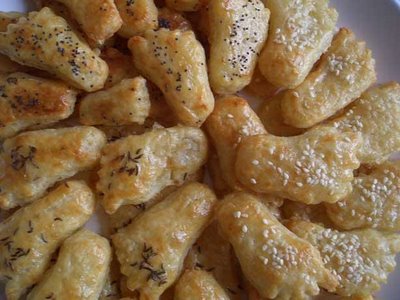I bought Paul Hollywood’s
100 Great Breads few months ago when I was in a serious bread-baking mood. I had used his recipe for the Greek and Cypriot Easter bread
Tsoureki during the Orthodox Easter this May, though back then I didn’t manage to find
mahlepi (sour cherry pits) nor
mastic (gum resin from mastic tree) anywhere in Edinburgh. I’ve since then managed to buy some in a small Greek shop in London, Bayswater* and am looking forward to baking with these unusual spices (Hollywood has recipes for Cypriot village bread
koulouri, and Cypriot
Laganes Bread, and I’m also looking forward to trying
tsoureki again, this time with all the seasonings; I’ve found several recipes using mahlepi and mastic in Susanna Hoffman's
The Olive and The Caper, and Claudia Roden mentions these as well).
Paul Hollywood’s book is alright, with quite a few interesting looking and unusual bread recipes that I’m tempted to try. It has a short introductory chapter about the history of bread and some useful breadbaking hints and tips, but it’s a book for wide rather than specialist audience. I suspect lots of the recipes have been simplified, which is good, especially if you’re looking something easy to bake on a spur of the moment late at night. However, I have a feeling that recipes have not always been properly tested and the editing is poor as well. Think of the above mentioned mastic and mahlepi. On page 78 Hollywood specifies that ‘mastika and mechlebe are spices and seeds used in many Greek/Cypriot dishes. They have a similar flavour to fennel or aniseed, which you can use to replace them. However, most good health food shops will stock them’. But in the Index of the book there are entries for ‘meclebe’ and ‘methlepi’!?!? How did they get the spelling wrong twice and didn’t it occur to them that ‘meclebe’ and ‘methlepi’ are the same thing and should actually be spelt ‘mechlebi’, as it was in the recipes? Or maybe mahlepi, as it is usually spelt in English.
Incorrect spelling and amounts aside, the recipes are tempting. The first recipe I tried was
Halloumi and Mint Bread (p 80). I quite enjoyed the recipe, though again, I think the recipe wasn’t correct. Trying to mix 2 packets – that’s 500 grams – of chopped halloumi cheese into a dough made with 500 grams of flour is ambitious. I also think that 20 grams of dried mint (that’s 4 commercial glass spice pots!!!) is outrageous, especially as on the accompanying photo the bread is anything but full of mint (I simply omitted the ‘0’ from the recipe). I’ve also more than halved the amount of salt in the recipe, as cheese is quite salty already**. I suspect that Paul Hollywood’s recipe was originally for more than 1 loaf and while reducing the amount of flour, amounts for some of the other ingredients have remained unchanged. But the bread itself is easy and tasty, soft and dense at the same time and duly recommended. I think I’ve got the amounts correct here.
Halloumi and Mint Bread(
Halloumileib)
Adapted from Paul Hollywood's book
100 Great Breads
500 g strong white flour
1 tsp salt
4 tbsp olive oil
30 g fresh yeast
2-3 dl warm water
250 g halloumi cheese cut into small pieces
a generous tbsp of dried mint
Mix flour, salt, olive oil and yeast in a big bowl,
adding water gradually (you may need less, as you’re just trying to bring the ingredients together).
Knead for about 8 minutes (or 5, if you are using a mixer).
Cover the bowl with a clean towel or clingfilm and
leave to rise for 1 hour.
Line a baking tray with parchment paper.
Add the cheese and dried mint to the dough and
shape into a longish loaf.
Lift to the baking tray and
leave to rise for another hour.
Dust the top of the loaf with some flour and
bake in a preheated 220˚C/425˚F oven for 25-30 minutes. The bread should be golden brown and crisp on the top.
Transfer to a wire rack to cool, and
cover with a kitchen towel if you want just slightly softer top.
Here’s a version I made in early June – with 2 packets of halloumi cheese trying to escape the bread :)

And here’s a slightly modified version I made yesterday – using mint as well as some Greek oregano, 1 packet of halloumi cheese (that proved to be more than enough) and some pitted Greek style black olives that I had in my cupboard after making my
entry for the Paper Chef # 8 (therefore the dark speckles that you may have mistaken for burnt cheese):

And finally a close-up of the bread – note the salty white dots of halloumi cheese:

It's almost time for lunch now, so I'm going to have some of the halloumi, olive, mint and oregano bread with some tea..
* Athenian Grocery, Greek-Cyprus & Continental Specialities, Wines and Spirits, 16a Moscow Road, Bayswater, London W2 7AX, Telephone 020 7229 6280
** I also had to modify his recipe for
Tsoureki considerably, as I was reluctant to use 30 grams of _dried_ yeast and 15 grams of salt per half a kilo of flour again:)
 Many British newspapers reported today on a list of ten most useful cookbooks, as compiled by Waitrose Food Illustrated. The panel consisted of restaurateurs, chefs and consumers, among them Aldo Zilli, William Sitwell, John Torode, Sophie Grigson.
Many British newspapers reported today on a list of ten most useful cookbooks, as compiled by Waitrose Food Illustrated. The panel consisted of restaurateurs, chefs and consumers, among them Aldo Zilli, William Sitwell, John Torode, Sophie Grigson.

























